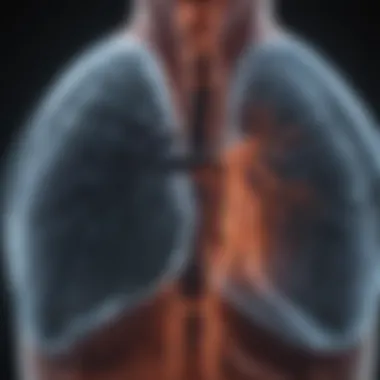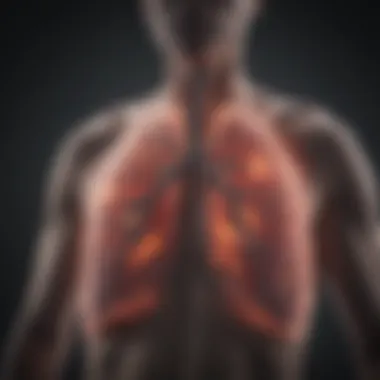Recognizing Early Signs of Lung Cancer: A Guide


Intro
Key Concepts
Definition of the Main Idea
Overview of Scientific Principles
Lung cancer develops when abnormal cells in the lungs begin to grow uncontrollably, often forming malignant tumors. The initial symptoms could stem from irritation of lung tissue or changes in lung function, but they may also arise from metastasis to other areas. Respiratory symptoms typically relate to the lung's functionality, while systemic symptoms often indicate that cancer has progressed or is affecting overall health.
Regular screening and monitoring are crucial for those at high risk, such as smokers or individuals with a family history of lung cancer. Healthy lifestyle choices and awareness of personal risk factors also play a role in prevention and early detection.
Current Research Trends
Recent Studies and Findings
Recent investigations into lung cancer have underscored the importance of recognizing initial symptoms. Studies suggest that patients who report early signs are often diagnosed sooner and have improved treatment outcomes. Research in the field continues to evolve, focusing on potential biomarkers for earlier detection and innovative imaging techniques to identify tumors at their nascent stages.
Significant Breakthroughs in the Field
Breakthroughs in genetic research are paving the way for more personalized approaches to lung cancer treatment. Understanding genetic predispositions can help assess risk and lead to targeted preventive measures. These advances will likely enhance early diagnosis and pave the road for innovative therapies, potentially improving the outlook for individuals diagnosed with this illness.
Recognizing the initial signs of lung cancer is crucial, as timely intervention is associated with a higher chance of successful treatment. By delving into the symptoms, making informed choices, and staying updated with ongoing research, individuals can enhance their chances of early detection and intervention.
Prolusion to Lung Cancer
Lung cancer remains one of the most pressing health concerns globally. It ranks among the leading causes of cancer-related deaths, often attributed to late-stage diagnoses. The subtlety of initial symptoms contributes to this concerning trend. Early signs of lung cancer can go unnoticed, leading patients to seek medical attention only when the disease has progressed significantly.
In this article, we will explore the myriad aspects of lung cancer, from understanding its biological underpinnings to the types that exist. Emphasizing the importance of recognizing initial symptoms, this piece aims to clarify how these often-overlooked indicators can guide timely intervention. Moreover, the content will elucidate the epidemiological context of this malignancy, identifying risk factors that contribute to its development.
This exploration will help readers appreciate the critical need for increased awareness surrounding the early manifestations of lung cancer.
Understanding Lung Cancer
Lung cancer typically originates in the lungs and can be categorized based on the type of cells involved. The disease can spread to other parts of the body, complicating treatment options further. The two primary classifications are non-small cell lung cancer and small cell lung cancer, each possessing distinct characteristics that influence their behavior and treatment strategies.
The genetic mutations associated with lung cancer play a significant role in its progression and treatment. Parents or siblings of individuals diagnosed with lung cancer sometimes carry mutations, increasing their risk. By comprehending lung cancer biology, we can better identify genetic predispositions that may affect patient outcomes.
Types of Lung Cancer
Lung cancer can be broadly divided into two types, which impact both prognosis and treatment options. Understanding these types is crucial for grasping the complexity of lung cancer and its initial symptoms.
Non-Small Cell Lung Cancer
Non-small cell lung cancer accounts for about 85% of all lung cancers. This type is characterized by different subtypes, including adenocarcinoma, squamous cell carcinoma, and large cell carcinoma.
The most common form is adenocarcinoma, which often arises in the outer areas of the lung. Non-small cell lung cancer is known to grow more slowly than its counterpart, small cell lung cancer. Because of this slower progression, patients may experience more prolonged initial symptoms that could easily be attributed to other conditions.
Small Cell Lung Cancer
Small cell lung cancer constitutes about 15% of lung cancer cases and is known for its aggressive nature. This type typically originates in the central regions of the lung. Early detection is vital, as small cell lung cancer is more likely to spread quickly to other organs. The presence of initial systemic symptoms, such as fatigue and weight loss, may be more pronounced in small cell lung cancer patients.
Both types of lung cancer share some common characteristics, particularly in terms of how they emerge, but the differences are significant.
In summary, understanding both types of lung cancer offers valuable insight for recognizing possible early symptoms and encourages individuals to pursue proactive diagnostic measures.
Epidemiology of Lung Cancer
The epidemiology of lung cancer is an essential section in understanding the broader impact of this disease. It highlights not only the prevalence and distribution across different populations but also sheds light on the significant risk factors contributing to its development. By focusing on these statistics and determinants, we can better appreciate the necessity of early detection and intervention.


Lung cancer continues to be a leading cause of cancer-related deaths globally. Knowledge of its epidemiological patterns can enhance public health strategies aimed at reducing incidence rates and improving survival through early diagnosis and treatment.
Global Statistics
Globally, lung cancer accounts for a substantial number of cancer cases. Approximately 2.2 million new cases are reported each year, making it the second most common type of cancer. Its lethality is marked, as it is responsible for over 1.8 million deaths annually, which represents a high mortality rate compared to other cancers.
In terms of geographical distribution, rates of lung cancer diagnosis and mortality vary significantly. High-income countries often report decreasing trends due to effective tobacco control policies. Conversely, regions in Asia, especially China, report escalating incidences. These stark contrasts emphasize the need for tailored public health interventions in various regions.
Risk Factors
Tobacco Smoke
Tobacco smoke remains the most significant risk factor associated with lung cancer. Studies indicate that about 85% of lung cancer cases are linked to smoking. The carcinogens present in tobacco smoke contribute to genetic mutations in lung cells, which can lead to the development of tumors.
The key characteristic of tobacco smoke lies in its composition, which contains over 7,000 chemicals, including at least 70 known carcinogens. The sheer volume of toxic substances makes tobacco smoking a particularly concerning risk factor.
One unique feature of tobacco smoke is its dose-response effect; higher consumption leads to greater risk. Furthermore, while efforts to quit smoking can significantly reduce the risks, former smokers remain at an elevated risk compared to non-smokers. This emphasizes the importance of smoking cessation programs in lung cancer prevention.
Environmental Exposures
Environmental exposures encompass a variety of harmful substances that can contribute to lung cancer development. These include asbestos, radon, and air pollution. Among these, radon gas is particularly noteworthy as it is a leading cause of lung cancer among non-smokers.
One key characteristic of environmental exposures is their often insidious nature. Unlike smoking, individuals may not recognize their exposure to these carcinogens until symptoms appear. The long latency period can delay diagnosis, making awareness crucial.
A unique feature is that environmental factors can often affect entire communities, heightening the importance of public health initiatives aimed at reducing exposure levels. One of the advantages of understanding environmental risks is the opportunity for preventive measures, such as improved air quality regulations and community awareness campaigns.
Genetic Predisposition
Genetic predisposition plays a crucial role in the development of lung cancer for some individuals. Research indicates that specific mutations can increase susceptibility, especially among those exposed to other risk factors like tobacco smoke. Notably, there are hereditary syndromes that can elevate the risk of lung cancer.
A key characteristic of genetic predisposition is that not everyone with risk factors will develop lung cancer, but certain genetic profiles may increase the likelihood. Identifying individuals with these genetic markers can lead to targeted screening and preventive strategies, thus improving early detection and treatment outcomes.
The unique feature of genetic predisposition is its interaction with environmental exposures. Individuals with a genetic predisposition who smoke, for instance, are at an even greater risk than those without such genetic factors. This highlights the importance of a multifaceted approach in risk assessment and prevention strategies.
Initial Symptoms Overview
Importance of Early Detection
Early detection of lung cancer is linked to higher survival rates. When lung cancer is caught in its initial phases, treatment options become more varied and potentially less invasive. Some studies indicate that lung cancer detected at an earlier stage may allow for surgical removal, which is often more successful than other treatments. Furthermore, detection while the cancer is still localized may reduce the necessity for extensive therapies like chemotherapy or radiation. This makes it all the more vital for individuals, especially those at risk, to be aware of the signs that precede a formal diagnosis.
Key Considerations:
- Awareness: Individuals should stay informed about the signs that suggest potential lung issues.
- Regular Health Checks: Those at higher risk can benefit from routine screenings, which may include imaging tests.
- Symptom Monitoring: Keeping a record of any persistent symptoms helps healthcare professionals in making timely assessments.
Common Initial Symptoms
- Persistent Cough: A cough that does not go away or worsens over time.
- Shortness of Breath: This can occur even during light activities, indicating potential lung involvement.
- Chest Pain: Discomfort or pain localized in the chest area can be a significant warning sign.
- Wheezing: Unexplained wheezing may suggest blockage or narrowing of air passages.
- Weight Loss: Unintended weight loss often signals more than just lifestyle changes.
- Fatigue: Continuous tiredness that does not improve with rest can be indicative of underlying issues.
Understanding these signs fosters a proactive approach to health. Recognizing early symptoms can prompt individuals to seek timely medical evaluation, which can ultimately contribute to a better prognosis.
Understanding these signs fosters a proactive approach to health. Recognizing early symptoms can prompt individuals to seek timely medical evaluation, which can ultimately contribute to a better prognosis.
By focusing on these early manifestations, including both respiratory and systemic symptoms, this discussion aims to equip readers with necessary knowledge that can influence health decisions and facilitate potential early diagnoses.
Respiratory Symptoms
Respiratory symptoms serve as critical indicators in the early detection of lung cancer. Understanding these signs can greatly enhance the likelihood of timely intervention and effective treatment. Early recognition of respiratory symptoms often allows for earlier diagnoses, which can significantly impact patient outcomes. In lung cancer cases, respiratory issues such as cough, breathe difficulties, chest pain, and wheezing may emerge initially, often mistaken for benign conditions. By differentiating these symptoms, healthcare professionals can focus on the proper diagnostic paths, offering patients a chance for improved health outcomes and therapeutic strategies.
Persistent Cough


Characteristics of the Cough
The persistent cough is a common initial symptom of lung cancer, standing out due to its duration and discomfort. Unlike a typical cough that resolves in a short time frame, a persistent cough lingers for weeks. This continuous nature raises concern, especially when associated with other symptoms. Key characteristics include:
- Duration: Lasting longer than three weeks, suggesting the need for medical evaluation.
- Appearance: May be dry or produce phlegm, often indicative of underlying pathology.
Recognizing a cough's characterization is essential because it can lead to critical diagnostic evaluations early in the disease process. Ignoring this symptom can delay diagnosis and treatment, ultimately affecting patient survival.
Pathophysiological Mechanisms
The pathophysiological mechanisms behind the persistent cough in lung cancer can involve several factors. Local inflammation from tumor growth irritates the airways. This irritation may trigger a cough response as the body attempts to clear obstructions or secretions. As a crucial characteristic, it is important for health professionals to understand that any change in cough patterns should prompt further investigations.
Shortness of Breath
Underlying Causes
Shortness of breath, or dyspnea, is another prominent symptom, often stemming from several physiological changes within the lungs. Typically, lung cancer affects airflow by disrupting normal lung function. This can be caused by:
- Tumor mass obstructing airways
- Fluid accumulation in the pleural space
By understanding these underlying causes, clinicians can frame better management plans regarding what symptoms to monitor closely.
Assessment Techniques
Assessment techniques for shortness of breath include physical exams and imaging studies. Pulmonary function tests can indicate how well the lungs are working. Chest X-rays and CT scans offer insights into structural changes. These assessment methods are important because they not only help diagnose lung cancer but also determine the extent of lung involvement. Regular monitoring can identify progression or response to treatment.
Chest Pain
Nature of Chest Pain
Chest pain associated with lung cancer has unique characteristics. Patients may experience localized pain that worsens with coughing or laughing. Unlike cardiac-related pain, which varies, lung-related discomfort often points towards respiratory involvement. Detecting the nature of this pain is crucial as it can reveal the cancer stage and guide imaging choices.
Clinical Significance
The clinical significance of chest pain lies in its potential to indicate advanced disease. Not all cases are straightforward; sometimes, pain may signal metastasis or associated pleural effusion. Therefore, recognizing this symptom can lead to timely imaging and intervention plans that improve patient care pathways.
Wheezing
Potential Mechanisms
Wheezing can occur as a result of airway obstruction in lung cancer. This symptom often arises from the narrowing of airways due to tumor presence or surrounding inflammation. Patients may describe a high-pitched sound during exhaling, indicating airflow restriction. Understanding the potential mechanisms behind wheezing aids in distinguishing between lung cancer and other obstructive airway disorders like asthma.
Comparative Analysis with Other Conditions
Lastly, conducting a comparative analysis of wheezing with similar conditions is essential. Symptoms can overlap with asthma, chronic obstructive pulmonary disease, and other pulmonary conditions. By highlighting this comparative aspect, healthcare professionals can better evaluate symptom patterns to avoid misdiagnosis, allowing for precise diagnostic strategies.
Early recognition of respiratory symptoms in lung cancer can lead to better outcomes for patients. Prompt evaluation is vital.
Early recognition of respiratory symptoms in lung cancer can lead to better outcomes for patients. Prompt evaluation is vital.
Systemic Symptoms
Systemic symptoms play a crucial role in understanding lung cancer, as they often signal the disease's impact beyond the respiratory system. Unlike localized symptoms, systemic manifestations show how cancer can affect the whole body. Initial systemic symptoms such as unexplained weight loss, fatigue, and loss of appetite are recognized indicators of underlying malignancies. They are often overlooked, but their significance in early detection is paramount. Identifying these symptoms can lead to timely diagnosis and treatment options, improving overall patient outcomes.
Unexplained Weight Loss
Implications for Diagnosis
Unexplained weight loss is a notable systemic symptom associated with lung cancer. When a patient experiences significant weight loss without trying, it raises suspicions about possible underlying conditions, including cancer. This symptom acts as a red flag, prompting healthcare professionals to investigate further. It is beneficial to the overall topic, as it guides the diagnostic process early on. The unique feature of this symptom is its ability to connect the dots between various clinical signs, leading to heightened awareness among patients and clinicians. Addressing unexplained weight loss provides insight into the disease progression and can facilitate more effective management strategies.
Connection to Metabolism


The connection between unexplained weight loss and metabolism is critical. Cancer can disrupt normal metabolic processes, leading to the body burning energy inefficiently. This phenomenon, known as cancer-induced cachexia, can result in rapid weight loss. Understanding this link enhances the overall comprehension of lung cancer's systemic impact. It also highlights the importance of nutritional interventions. However, distinguishing between weight loss due to cancer-related metabolism changes and other health issues can be challenging, creating a need for careful evaluation.
Fatigue
Evaluation of Fatigue
Fatigue is another prevalent systemic symptom in lung cancer patients. It differs from generalized tiredness, as it significantly affects daily functions and quality of life. Careful evaluation of fatigue is essential in identifying its causes, be it cancer itself, treatment side effects, or comorbid conditions. This symptom is included in the article for its relevance to patient care and its potential to indicate the disease's seriousness. The unique feature of this symptom is its subjectivity; patient reports are crucial for understanding its impact. Health professionals must consider fatigue in the broader context of lung cancer treatment and management plans.
Associated Mechanisms
The mechanisms associated with fatigue in lung cancer are complex. Factors such as systemic inflammation, metabolic changes, and psychological distress contribute to a patient’s sense of exhaustion. Recognizing these mechanisms is important for holistic patient assessment and intervention. Addressing fatigue comprehensively can improve the quality of life and treatment adherence in patients.
Loss of Appetite
Link to Cancer Progression
Loss of appetite can be a critical symptom linking lung cancer to disease progression. As cancer advances, it may trigger changes in hormonal and metabolic pathways that result in reduced desire to eat. This symptom underscores the importance of comprehensive evaluations in suspected lung cancer cases. Including it in the discussion illuminates how early recognition can influence treatment strategies. The connection it holds to patient quality of life extends beyond the physical realm.
Impact on Nutritional Status
The repercussions of loss of appetite extend to nutritional status. Reduced food intake can lead to malnutrition, weakening the patient's physical condition and hindering treatment efficacy. Nutritional assessment becomes vital in lung cancer care. Addressing this impact is beneficial for both clinicians and patients. Recognizing the importance of maintaining nutritional health can guide supportive care measures, such as dietary adjustments or nutritional supplements.
Differential Diagnosis
Differential diagnosis plays a critical role in the field of medicine and is particularly important in the context of lung cancer. When patients present symptoms that may indicate lung cancer, it is crucial for clinicians to distinguish these from other conditions that could cause similar manifestations. This is essential because many diseases can mimic the signs of lung cancer, leading to delays in appropriate treatment if not correctly identified.
The primary benefit of a differential diagnosis in lung cancer is that it allows for timely interventions. Early detection of lung cancer significantly increases treatment success rates. Thus, a thorough consideration of other potential conditions is fundamental. Moreover, understanding common conditions that present with similar symptoms helps guide the necessary diagnostic approach, ensuring that patients receive the correct evaluation and management.
Common Conditions Mimicking Symptoms
- Chronic Obstructive Pulmonary Disease (COPD): COPD often causes shortness of breath and cough, symptoms that overlap with early lung cancer.
- Pneumonia: This can present with cough, chest pain, and fatigue, making it necessary to rule out.
- Tuberculosis: An infectious disease with respiratory symptoms similar to those of lung cancer.
- Asthma: Characterized by wheezing and shortness of breath, asthma can be confused with lung cancer-related symptoms.
- Interstitial Lung Disease: It can present with similar respiratory complaints, requiring differential investigation.
Recognizing these conditions is vital to avoid misdiagnosis and ensure the right tests and measures are taken.
Importance of Diagnostic Testing
Diagnostic testing is fundamental in confirming a diagnosis when evaluating the initial symptoms associated with lung cancer. With advancements in technology, multiple testing modalities are available that effectively contribute to the overall goal of accurate diagnosis.
Imaging Techniques
Imaging techniques, particularly chest X-rays and computed tomography (CT) scans, are essential tools in this evaluation process.
A chest X-ray provides an initial visual assessment of lung abnormalities. However, it may not reveal smaller lesions which can be detected on a CT scan.
CT scans are significant due to their high sensitivity in identifying tumors and other lung conditions. They allow for detailed imaging of the lungs, revealing the size and location of potential masses. The key characteristic of imaging techniques is their non-invasive nature, making them a popular choice for initial evaluations.
However, they are not without disadvantages. Over-reliance on imaging can lead to overdiagnosis or anxiety due to false positive results.
Biomarkers and Blood Tests
Biomarkers and blood tests are increasingly valuable for their ability to inform diagnostic processes and assist in the identification of lung cancer risk. The primary characteristic of these tests is that they can measure specific substances released by tumors into the bloodstream.
For instance, the detection of chromosomal changes in blood samples can indicate malignancy.
One unique feature of these tests is their potential for identifying cancer in its earlier stages compared to imaging alone. However, a limitation lies in their availability and the need for further validation before widespread adoption.
Incorporating both imaging techniques and biomarkers can enhance diagnostic accuracy, giving a more comprehensive view of a patient's condition. Understanding these diagnostic methods allows healthcare professionals to make informed decisions, significantly impacting patient outcomes.
Finale
Summary of Key Points
- Importance of Early Recognition: The initial symptoms, often nonspecific, can easily be overlooked. Awareness can lead to early consultations with healthcare providers.
- Range of Symptoms: These encompass both respiratory and systemic manifestations, including persistent cough, unexplained weight loss, and fatigue.
- Differential Diagnosis: Knowledge of other conditions that may mimic lung cancer symptoms aids in proper assessment and mitigates unnecessary anxiety for patients.
- Lifestyle and Genetics: Factors such as smoking history and family medical backgrounds play a considerable role in the risk for lung cancer.
"Understanding the early signs is crucial; proactive measures can save lives."
"Understanding the early signs is crucial; proactive measures can save lives."
Encouragement for Awareness
This article aims to enlighten individuals about the major symptoms that may indicate lung cancer, encouraging them to seek medical advice without delay.
Health literacy is vital. Individuals informed about the symptoms are more equipped to navigate their health journeys. Regular check-ups and open dialogue in families can foster discussions, reducing stigma and enhancing early diagnosis. Emphasizing education on lung cancer can create a culture where individuals prioritize their health, making informed decisions. Adopting a proactive approach promotes timely interventions and ultimately leads to improved outcomes for those at risk.







